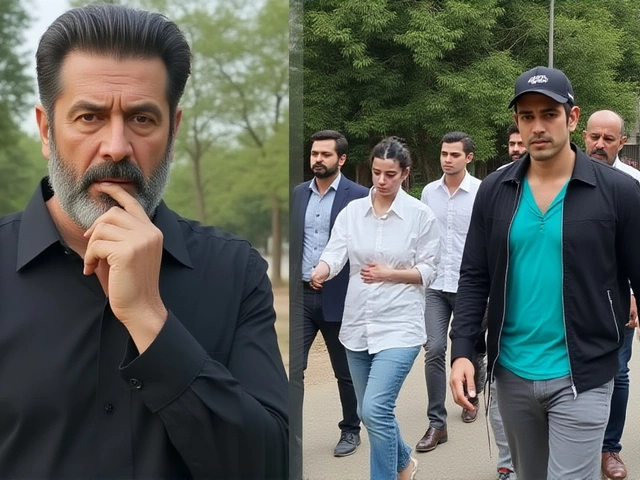What we know about the Utah shooting and the fast-moving investigation
A midday campus event turned into a national shock on September 10, 2025, when Charlie Kirk—the 31-year-old conservative organizer who founded Turning Point USA—was shot and killed while speaking with students at Utah Valley University in Orem. The attack happened in broad daylight, during an outdoor stop on his American Comeback Tour, and it unfolded on camera as students recorded the exchange on their phones.
Campus police responded within minutes. Law enforcement locked down parts of the university and evacuated buildings around the scene. By evening, the FBI had taken the lead on the case and opened a public tip line, announcing a $100,000 reward for information that leads to an arrest and conviction. Investigators recovered a high-powered rifle discarded in a wooded area near campus. Forensic teams are testing the weapon, analyzing footprints, and mining security footage from the university and nearby businesses.
Two people detained in the initial confusion were later released after questioning, authorities said. The FBI also circulated images of a person of interest, asking the public to study clothing, gait, and any distinctive markings that could help pinpoint identity. As of now, officials say they’re pursuing multiple leads and reviewing digital evidence—video angles from witnesses, license plate data from traffic cameras, and phone records that could place a suspect near the scene.
The shooting happened while Kirk was hosting his “Prove Me Wrong” format, a combative but controlled style of campus dialogue that draws large, vocal crowds. Organizers promote it as a chance for students to challenge conservative viewpoints in an open forum. On this day, the forum had only begun when a single gunshot cut through the crowd, sending students scrambling for cover. Witness videos rapidly spread across social platforms, fueling outrage and grief in the hours that followed.
Here’s the picture that has emerged so far, based on law enforcement briefings, campus statements, and Turning Point USA’s account:
- Around noon local time, Kirk stepped onto the outdoor stage area for a Q&A-heavy stop on his tour.
- Shortly after he began fielding questions, a single gunshot was fired. First responders treated Kirk on-site before he was pronounced dead.
- Police secured the scene, evacuated nearby buildings, and began a door-to-door sweep. A rifle was later found not far from campus.
- Investigators reviewed surveillance video and witness clips, identified a person of interest, and appealed to the public for tips. A $100,000 reward was posted.
- Two people initially taken into custody were cleared and released.
Turning Point USA, the organization Kirk launched as a teen, confirmed his death in a statement that asked supporters to pray for his family. The post referred to him by his full name, Charles James Kirk, and described his killing as a gunshot homicide during their official campus tour stop.
The political response was immediate and bipartisan. Lawmakers, governors, and prominent figures across the spectrum condemned the shooting and warned about the spiral of political rage. The tone echoed other moments in recent American history when violence crashed into public life: the 2011 shooting of Rep. Gabby Giffords, the 2017 baseball practice attack that wounded Rep. Steve Scalise, the 2022 hammer attack on Paul Pelosi at his home, and the 2024 attempted assassination of Donald Trump at a Pennsylvania rally.
Trump, long one of Kirk’s closest allies, posted a personal tribute on social media. He called Kirk “Great” and “Legendary,” praised his bond with young voters, and offered condolences to his wife, Erika, and their family. The next day, at a 9/11 memorial event at the Pentagon, Trump said he would posthumously award Kirk the Presidential Medal of Freedom. That announcement underscored how central Kirk had become to the conservative project to organize and energize younger voters.
Behind the scenes, the law enforcement playbook is straightforward but painstaking. The ATF will trace the rifle’s serial number and sales history. Forensic teams will compare ballistic markings from the recovered weapon to the bullet and any shell casings. Analysts will stitch together camera angles to build a suspect timeline: approach routes, escape paths, and vehicle sightings. Detectives will run down tips about unusual behavior in the days prior—recon trips, lodging near campus, or social posts that hint at motive.
Security questions are already mounting. Outdoor campus events are open by nature; they’re designed to draw in passersby and start conversations. That makes them easier to access—and harder to secure. Universities rely on a mix of uniformed officers, plainclothes security, and crowd control barriers. Bag checks and magnetometers are sometimes used, but not always, and rarely for sprawling outdoor settings without ticketing. Those choices will now face scrutiny from parents, students, and campus administrators nationwide.
As the case moves forward, investigators will watch for patterns: Was the attack planned or opportunistic? Was the suspect local, or did they travel to Utah for the event? Did the shooter scout the venue beforehand? Answers to those questions will shape both the manhunt and the debate about how to protect public figures who deliberately put themselves in open spaces to make a point.
Who he was, what he built, and why his death lands so hard
Charlie Kirk’s path in politics started early. At 18, he founded Turning Point USA in 2012 to seed conservative clubs on college campuses and train student activists. What began as a shoestring outfit grew into one of the most visible youth-focused brands on the right, with chapters, conferences, and a presence at Republican gatherings around the country. The group is best known for tabling on quads, building student networks, and staging punchy events that often go viral.
Kirk understood the power of media as much as the ground game. He ran a daily show and podcast, traveled constantly, and turned campus spats into national moments. He wrote books aimed at a young conservative audience—most notably The MAGA Doctrine in 2020—and honed a message that blended free-market talk with culture-war issues like campus speech codes, DEI programs, and what he cast as left-wing orthodoxy in universities.
That approach made him a magnet for praise and criticism. Supporters saw someone who would show up in blue-state college towns and argue face-to-face. Critics accused him of inflaming tensions, pointing to Turning Point’s Professor Watchlist, which flagged academics for alleged leftist bias. Either way, Kirk rarely ducked a fight. He embraced confrontation as a teaching tool, and the “Prove Me Wrong” format captured that ethos—a structured clash of ideas, designed for short clips and sharp lines that spread online.
His relationship with Donald Trump turned a youth project into a political force. Kirk backed Trump early, organized students for rallies, and acted as an on-ramp for younger conservatives into the GOP. He spoke at the 2020 Republican National Convention and was a regular at movement conferences that mixed campus activists with party leaders and influencers. The bond was personal as much as tactical: Trump praised Kirk’s knack for mobilizing students; Kirk defended Trump’s agenda in language tailor-made for social media.
Money followed the momentum. As Turning Point’s profile rose, so did its donor network, funding national conferences, training programs, and a constant stream of campus events. With that scale came a bigger target on the group’s back—more protests, more hecklers, and tighter security needs. The atmosphere around campus politics has been heated for years; the line between activism, harassment, and actual violence has grown worryingly thin.
America has been here before. High-profile shootings of political figures have pushed the country into hard conversations about rhetoric and security: the Giffords attack in Arizona, the Scalise shooting in Virginia, and the 2024 attempt on Trump that killed a rallygoer and wounded others before the gunman was neutralized. Each time, the nation wrestled with the same trade-offs—open access versus hardened perimeters, lively debate versus real-world risk.
Kirk’s killing adds a stark new chapter to that story because of where it happened and who he was. Universities are supposed to be arenas for argument, not ambushes. Kirk built his brand on showing up to argue. He didn’t hide behind press releases; he took questions live, under the sun, with cameras rolling. That posture—confident, brash, and deliberately exposed—was central to his appeal. It also made him vulnerable.
In the days ahead, Turning Point USA and partner organizations will have to rethink logistics: venue selection, perimeter control, speaker routes, and emergency protocols. Expect a shift toward ticketed indoor spaces, staggered entry, bag checks, and magnetometers—even for events billed as casual meetups. That may change the vibe of campus stops, but the pressure to adapt will be intense given the stakes and the visibility.
Meanwhile, investigators will keep pressing the details. Ballistic reports can take time, but they often open doors—linking a firearm to prior incidents or tying a suspect to ammunition purchases. Device forensics can be just as powerful. Geofence warrants, cell-site data, and app location histories can place a phone at the scene. If the person of interest used a car, plate readers and toll data may help build a route into and out of Orem, narrowing the suspect pool by the day.
The political world will move just as quickly. There will be tributes and fundraisers, and there will be calls—loud ones—for less demonization across the board. If past cycles hold, those calls will collide with raw anger and mistrust, especially online. The memory of the shooting will become part of the broader fight about how America talks, campaigns, and protests. That’s not cynical; it’s how modern politics absorbs trauma—instantly, and in full view.
For Kirk’s allies, the focus is legacy. They’ll point to the students he recruited who went on to staff campaigns, run campus groups, and flood local party committees with new volunteers. They’ll note how he made conservative ideas feel kinetic to a generation that might otherwise have checked out. For his critics, the debate will be about boundaries—what’s fair rhetoric, what’s reckless, and how leaders with huge platforms should balance influence with responsibility.
None of that answers the most urgent question: who pulled the trigger and why. Until investigators land on a suspect—and a motive—speculation will fill the gap. Authorities are asking anyone with videos, photos, or first-hand details to come forward. Every small detail matters in cases like this: a distinctive jacket, a backpack, an odd route someone took after the shot. Offline, those fragments become leads. Stitched together, they become a case.
For now, a family is grieving, a movement is stunned, and a campus is trying to make sense of a shooting that happened in the middle of a weekday, at a microphone, under the mountain sun. The search is on, the politics are already raw, and the country is watching yet another test of how our public square survives violence aimed right at its center.




